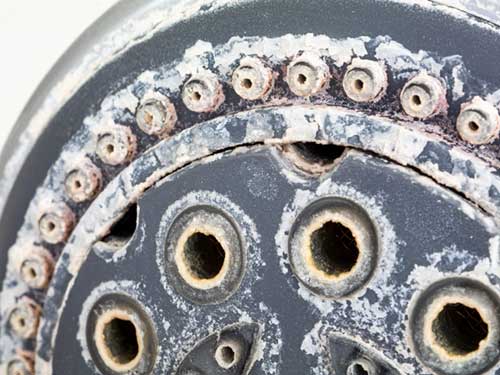What is Hard Water?
Water
What is Hard Water?
“What is hard water?” is a question we quite often get asked. Hard water is the result of the dissolved minerals Ca (calcium) and Mg (magnesium). These minerals become less soluble at high temperatures and form a white precipitate (solid). This characteristic is what causes most of the problems with hardness.

One of the most common signs of hard water is the buildup of soap scum in your shower or spots on your faucets. That’s because minerals in hard water mix with soap to create a sticky film that’s hard to wash away. This residue can also stay on your skin, hair, and clothes, making your skin dry, your hair dull, and your clothes fade faster.
In hot water heaters and tankless coils, the minerals will deposit on the hot surfaces and cause scaling. This scaling will not only reduce the efficiency of these units but can be severe enough to completely block the passages in and out of the heaters. Hard water will also cause dry skin, itchy stiff fabrics, spots on dishes or freshly cleaned fixtures and excessive soap use. Soap scum build up (bath tub ring) is caused by hardness precipitating with the soap it removes from the water. Detergents have additives that are designed to overcome this problem but even these additives have limits on how much hardness they can handle.
These hardness minerals will sometimes precipitate in the screens of the aerators on faucets. These precipitated particles are often mistaken for sand. The customer usually puts on a cartridge filter where the water comes into the house and the problem will persist. He will continue to change filters and still have problems. The reason the filters do not work is because the hard water minerals come into the house and pass through the filter while still dissolved in the water (like sugar water would pass through the same filter). The minerals don’t precipitate until they are heated and mix with the air at the faucet. An easy way to confirm that the material at the faucet is not sand is to place it in an acid and see if it fizzes. Although the reaction may be slow, vinegar (acetic acid) or lemon juice (citric acid) should cause the minerals to fizz.
TREATING HARD WATER – HOW A WATER SOFTENER WORKS
The only treatment for hard water in a residential situation is with a water conditioner (water softener). The water softener consists of two tanks- a resin tank and a brine (salt) tank. The resin tank is filled with a media that is small plastic beads. The beads have a permanent charge. The charge causes the beads to attract positively charge ions (charged atomic particles). The media is placed into service with Na (sodium) ions on the beads. When the hardness ions (Ca and Mg) come in contact with the Na, they remove the Na and take the Na’s place on the beads. The Na is now dissolved in the water. When all the Na is removed from the beads the media is regenerated with a high concentration of NaCl (salt) solution. The salt solution contains Na ions and Cl (chloride) ions. The Na is placed back onto the beads and the Ca and Mg are washed down the drain. Some people are concerned about the amount of sodium they are adding to the water. This can be calculated and in almost all cases is very insignificant. If the customer is adamant about not using Na, KCl (potassium chloride) can be used instead. This will add K (potassium) to the water. The most common KCl product is called K-life and is about twice as expensive as sodium chloride. Both the NaCl and KCl can be bought in 40 – 80# bags that are dumped into a container that is attached to the tank with the beads.
HOW TO WE TREAT HARD WATER?
Air & Water Quality can solve your water softening needs with a Kinetico water softener. This two tank systems provides an uninterrupted supply of treated water. One tank is always on line and one is on stand-by. When the on line tank is exhausted and needs regeneration, the stand-by tank is put into service. All of this is done with the energy of flowing water. There is no electricity or electrical components required. In addition, Kinetico water softeners are protected by a 10-year warranty on all parts.
Water Resources



